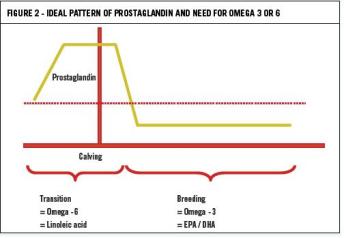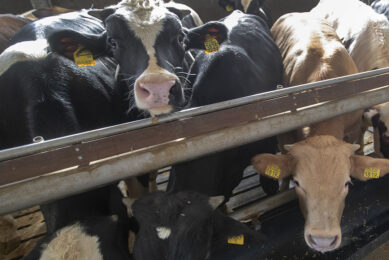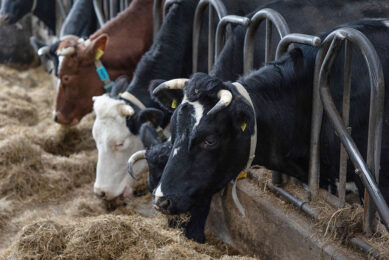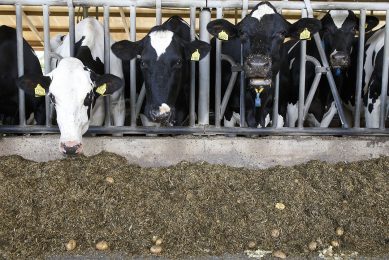Healthy fatty acids for better fertility in cows

Pregnancy rates in cows have declined as milk production has increased over the last decades. Provimi has introduced a new nutritional programme involving omega 3 and 6 fatty acids. This fertility programme showed increased pregnancy rates, which in turn leads to increased profit on the farm. Pieter Wolleswinkel and Sander Abrahamse explain the facts.
Omega-3 and 6 fatty acids currently receive a lot of attention in human nutrition. Evidence is growing that these fatty acids not only positively affect human health, but also have beneficial effects on the health of dairy cows. In particular, omega-fatty acids have been shown to influence the production of the hormone prostaglandin in the uterus. Synthesis of prostaglandin leads to the regression of the corpus luteum, the progesterone producing structure on the ovary (Failrough et al, 1975; Schindler et al, 1990). This will induce parturition and stimulate contraction of the uterus.
Seals et al (2002) concluded that cows diagnosed without endometritis post partum had a higher level of prostaglandin at calving compared to cows with endometritis, emphasising the positive role that prostaglandin plays during the peripartum period. Omega-6 (linoleic acid) can be converted in the animal through enzymatic reactions into arachidonic acid, which is the precursor of prostaglandin. With the beneficial effects of prostaglandin on endometritis and retained placenta (Gross et al, 1987; Heuwieser et al, 1992), feeding linoleic acid prepartum is thus expected to support the uterus around calving. This will promote the ability of the uterus to conceive again.
Different sources of Omega-3
When the uterus has recovered after calving, it is time to inseminate the cow. Insemination does however not always lead to pregnancy, largely due to early embryonic losses. In high producing lactating dairy cattle, substantial losses of pregnancy occur up to 42–56 days after insemination (Santos et al, 2004). Several factors affect pregnancy losses in cattle, such as suboptimal recognition of the embryo. The production of prostaglandin, initiated when no embryo is recognised, causes loss of a viable embryo in the uterus (Thatcher et al, 1995). To achieve higher pregnancy rates, the level of prostaglandin in the uterus should be reduced to preserve the corpus luteum. This ensures progesterone production, which is vital for embryo survival. Omega-3 fatty acids are known to suppress the production of prostaglandin (Achard et al, 1997).
Especially eicosapentaenoic acid (C20:5, n-3, EPA) and docosahexaenoic acid (C22:6, n-3, DHA) have shown a significant effect on prostaglandin (Figure 1). This effect is much larger compared to the effects of omega-3 fatty acids from vegetal sources like linseed (Mattos et al, 2003). Research strongly indicates that feeding fish oil to the animals is the best strategy to protect the corpus luteum.
Rumen inert
In the cow’s rumen, dietary unsaturated fatty acids, like omega-6 and 3 are extensively biohydrogenated. Unsaturated fatty acids are metabolised into saturated fatty acids by rumen bacteria, resulting in substantial losses of omega fatty acids (Shingfield et al, 2003; Chillard et al, 2000). Part of the biohydrogenation process in the rumen is incomplete, resulting in production of trans fatty acids. The two most well known are trans-10 C18:1 and trans-10 cis-12 C18:2 (Bauman and Griinari, 2003).
These fatty acids can depress milk fat production up to 50%. In many countries, milk prices for dairy farmers are based on milk solids. Lower milk fat content then results in a lower milk price for dairy farmers. Additionally, unsaturated fatty acids in the rumen have a detrimental effect on rumen micro-organisms. This results in decreased fibre digestibility and thereby a reduced dry matter intake (Doreau and Chilliard, 1997). Especially during the transition phase and in early lactation cows are already in a negative energy balance. Maximising dry matter intake is crucial for animal health and production. For that reason reduced fibre digestibility is an undesirable effect in high yielding dairy cows.
Fertility programme
Virtus Nutrition LLC, a US based Provimi company, has developed a patented technology to make it possible to feed omega fatty acids in dairy cows. The technology makes the fatty acids rumen inert. This avoids the negative effects of unsaturated fatty acids in the rumen and allows the fatty acids to pass to the intestine. There, these fatty acids can be absorbed. The Strata-G Fertility Programme is designed to support the physiological effects of prostaglandin. The programme consists of feeding two products consecutively. The first product is Strata-G Dry Period with a high level of omega-6. It should be fed at least two to three weeks prior to calving to ensure sufficient tissue build up of omega-6 before calving. This omega-6 can be converted to prostaglandin.
After the transition period, Strata-G Dry Period is replaced by Strata-G Lactation. This contains a high level of EPA and DHA from fish oil, and should be fed for at least four to five months after calving, to ensure that the beneficial effects of these omega-3 fatty acids on prostaglandin cover the period of insemination plus the first two months of pregnancy (Figure 2). This latter product has proven not to affect milk fat levels and dry matter intake in an experiment where Strata-G lactation was tested versus unprotected fish oil. Milk fat level was 23% higher in the Strata-G Lactation group: 3.61% vs. 2.76%. Dry matter intake was 2.6 kg lower in the group fed unprotected fish oil (Castaneda- Gutierrez et al, 2007). In a recent trial in the Netherlands, the effect of Strata-G Lactation on milk fat levels compared to an iso-energetic control was tested.
Four groups of cows were fed grass silage or maize silage based diets with or without Strata-G Lactation. Milk fat content was similar between both treatments in both types of diets (Table 1).
It is necessary that, once fatty acids have passed the rumen, they are absorbed in the intestine. Invasive in vivo research carried out by Bilby et al (2006) indicates a significant increase of EPA and DHA in the endometrium from cows fed with Strata-G Lactation. This proves that these fatty acids are taken up in the intestine as well as transported to the targeted organ.
Study at University of Florida
The Strata-G Fertility Programme has been tested at the University of Florida (Silvestre et al, 2008). In this experiment, performed on a commercial farm, more than 500 cows were used, to get reliable fertility data. The combination of Strata-G Dry Period and Strata-G Lactation was compared with an iso-energetic control diet with the same amount of fatty acids. The only difference was the level of omega-3 and -6 fatty acids. A hormonal synchronising programme was used and the first insemination was at day 83 after calving.
Pregnancy diagnosis was carried out at day 32 after insemination. If not pregnant cows were re-inseminated three days later. A second pregnancy diagnosis was carried out at day 60 after insemination to measure embryonic loss between day 32 and day 60. The pregnancy rate after two inseminations on day 60 was 48% in the control and 55% in the Strata-G group, a relative improvement of 15%. The effect was partly due to an improved pregnancy rate at day 32 after insemination (55% vs. 60% in control and Strata-G group, respectively) and partly due to reduced embryo losses between days 32 and 60 (10% vs. 7% in control and Strata-G group, respectively). The improvement in pregnancy rates implies that fewer cows need to be culled due to infertility on dairy farms. Besides, in this experiment milk production was on average 1 kg greater in the Strata-G group than in the control. No negative effect on body condition score was found despite the higher milk production and same energy levels of the diet.
Conclusion
Focusing on the type of fatty acids in dairy cows rations is the start of a new phase in dairy nutrition. Laboratory research in the last decade already indicated the physiological effect of omega-fatty acids on the fertility hormone prostaglandin. Rumen inert omega-6 and omega-3 products have now shown that under practical conditions pregnancy rates can increase 15% when fatty acid nutrition is optimised for fertility. These products give dairy nutritionists a tool to reverse the downward trend in cattle fertility on dairy farms.
*References are available on request
Source: Feed Mix magazine Volume 16 No. 6











